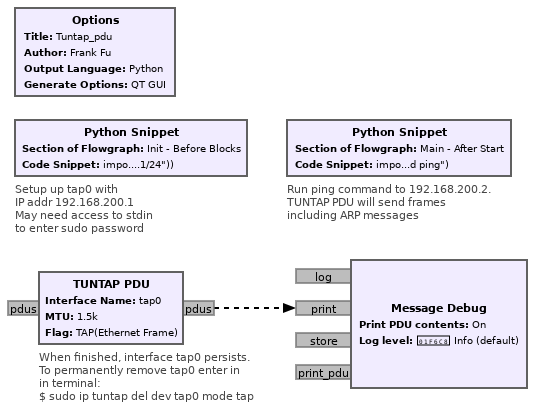TUNTAP PDU: Difference between revisions
(add Example Flowgraph) |
|||
| Line 1: | Line 1: | ||
[[Category:Block Docs]] | [[Category:Block Docs]] | ||
Creates TUNTAP interface and translates traffic to PDUs. See [https://en.wikipedia.org/wiki/TUN/TAP TUN/TAP] for an explanation of the functions. | Creates TUNTAP interface and translates traffic to PDUs. See [https://en.wikipedia.org/wiki/TUN/TAP TUN/TAP] for an explanation of the functions. | ||
| Line 6: | Line 5: | ||
sudo ifconfig tun 192.168.200.1 | sudo ifconfig tun 192.168.200.1 | ||
or: | |||
sudo ip addr add dev tun 192.168.200.1/24 | |||
sudo ip link set dev tun up | |||
GNU Radio needs root privileges to use this block. | GNU Radio needs root privileges to use this block. | ||
Alternatively, the "ip" command can be used beforehand to create a persistent tun or tap interface owned by the user. The following commands set up a persistent tap interface named tap0 with an IP address of 192.168.200.1: | |||
sudo ip tuntap add dev tap0 mode tap user $USER | |||
sudo ip addr add dev tap0 192.168.200.1/24 | |||
sudo ip link set dev tap0 up | |||
Once these commands are run, GNU Radio no longer needs root privileges to use this block. | |||
Afterwards, to delete the tap0 interface: | |||
sudo ip tuntap del dev tap0 mode tap | |||
<b>Note for 3.10</b> This block has been moved from gr-blocks to gr-network, which causes a name change of the id. See [[Porting_Existing_Flowgraphs_to_a_Newer_Version]] for details. | <b>Note for 3.10</b> This block has been moved from gr-blocks to gr-network, which causes a name change of the id. See [[Porting_Existing_Flowgraphs_to_a_Newer_Version]] for details. | ||
| Line 24: | Line 39: | ||
== Example Flowgraph == | == Example Flowgraph == | ||
[[file: Tuntap_pdu_fg.png]] | |||
<p>This flowgraph can be downloaded from [[Media:Tuntap_pdu.grc]].</p> | |||
== Source Files == | == Source Files == | ||
Latest revision as of 15:06, 30 April 2025
Creates TUNTAP interface and translates traffic to PDUs. See TUN/TAP for an explanation of the functions.
When the TUN option is chosen, a virtual ethernet interface is allocated to the specified Interface name (tun). It's IP address can then be set by:
sudo ifconfig tun 192.168.200.1
or:
sudo ip addr add dev tun 192.168.200.1/24 sudo ip link set dev tun up
GNU Radio needs root privileges to use this block.
Alternatively, the "ip" command can be used beforehand to create a persistent tun or tap interface owned by the user. The following commands set up a persistent tap interface named tap0 with an IP address of 192.168.200.1:
sudo ip tuntap add dev tap0 mode tap user $USER sudo ip addr add dev tap0 192.168.200.1/24 sudo ip link set dev tap0 up
Once these commands are run, GNU Radio no longer needs root privileges to use this block.
Afterwards, to delete the tap0 interface:
sudo ip tuntap del dev tap0 mode tap
Note for 3.10 This block has been moved from gr-blocks to gr-network, which causes a name change of the id. See Porting_Existing_Flowgraphs_to_a_Newer_Version for details.
Parameters
- Interface name
- Device name to create
- MTU
- Maximum Transmission Unit size
- Flag
- Flag to indicate TUN or Tap
Example Flowgraph
This flowgraph can be downloaded from Media:Tuntap_pdu.grc.
Source Files
- C++ files
- TODO
- Header files
- TODO
- Public header files
- TODO
- Block definition
- TODO
